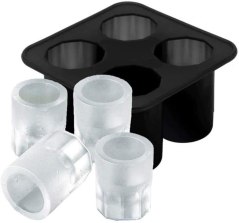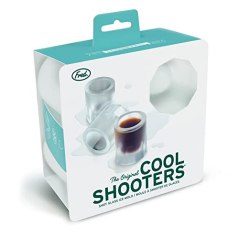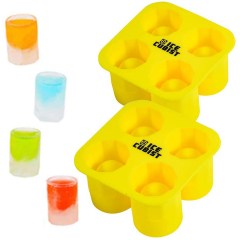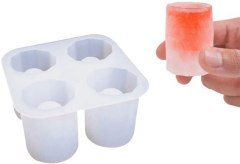BestReviews is reader-supported and may earn an affiliate commission. Details

This mold can hold 4 shot glass-shaped ice cubes of up to 1oz of liquid.
A non-stick silicone tray that can be safely washed in the dishwasher. The smaller square shape can fit easily into the freezer and has a study design for a secure hold. The smooth release process keeps the shape intact when removing.
Size is smaller than expected.
A versatile option that works for both frozen and baked shot glasses. Hands-down the best choice for the money.
Can be used for ice, cookie dough, candies, chocolate, jello, and more. Withstands temperatures up to 500°F. Makes 8 uniformly shaped shot glasses. Owners praise the construction quality and ease of use. Affordable, fun, and highly functional.
Some owners report that cookie dough leaves a hard-to-remove oily residue.

A nicely packaged option that works well as a gift, but with only 4 molds per tray, we feel it's a bit overpriced.
Silicone construction is suitable for both oven and freezer use. Produces reasonably thick walls and bases. Cavity holds a full shot. Oven safe up to 450°F. Dishwasher safe for easy cleaning. Nicely packaged.
Some owners found them difficult to remove and others complained of inconsistent shapes.

While strictly for shots created in the freezer or refrigerator, it has a high capacity and can be easily stacked for storage.
This pack of 2 stackable molds creates a total of 8 shots. Made from food-grade silicone. Easy to clean and won’t stain. Can be used for tasks such as freezing ice and ice cream shots and refrigerating gelatin shots.
Not for use in the oven. Some owners have had issues removing shots from the mold.

Food-grade silicone tray with 4 shot glass shapes that can be filled with various liquids for a fun party addition.
Tray measures 5 x 2.5 x 5 inches and is simple to use. Can be used to hold liquids for alcoholic or non-alcoholic drinks, as well as foods such as jello or pureed fruit. Mold is flexible and creates thick-rimmed ice glasses. Available at an accessible price.
These do tend to melt pretty quickly, particularly when used with alcohol.

We recommend these products based on an intensive research process that's designed to cut through the noise and find the top products in this space. Guided by experts, we spend hours looking into the factors that matter, to bring you these selections.

Shot glass molds are one of those kitchen items you might not think you need — until you try one. These simple tools can be used to create, among other things, ice shot glasses for vodka or whiskey, chocolate shot glasses for mellower liqueurs, and even cookie dough shot glasses for unique desserts.
Some of the best shot glass molds can be used in the freezer or the oven and are surprisingly effective at turning a run-of-the-mill meal or social gathering into a memorable event.
From the shape and size of molds to specifics concerning materials, pricing, and the number of shot glasses you can create at a time, there are many factors to consider before you buy shot glass molds for your kitchen.

Are you interested in making frozen shot glasses, or are cookie dough glasses more appealing to you? Many shot glass molds can be used in both the freezer and the oven, providing a wide range of applications, from beverage glasses to playful or fancy desserts.
While the majority of these multipurpose molds can handle temperatures as low as -40°F, the upper temperature limit can vary considerably. A mold with an upper range of 450°F to 500°F offers much more versatility than one with, say, a 230°F limit. Some shot glass molds are not recommended for use in the oven at all.
Check the item details or included instructions to learn how a particular shot glass mold is to be utilized.
Much like traditional shot glasses, the standard shape of these molds is usually that of a round or cylindrical shot glass. Some molds, though, are designed to create square shot glasses or other interesting shapes.
Note that the further a design deviates from a round shape, the more difficulty you may have when removing the shot glasses from the mold.
The size of the glasses produced varies from mold to mold. While some molds produce shot glasses that align with traditional shot glass sizes (capable of holding an ounce or so of liquid), others can be used to make larger cups. These larger molds may be more appropriate for creating unique desserts, such as edible mousse shells.
Consider how you plan to use your mold before choosing on a specific size.
After making cookie shot glasses, line them with chocolate or another candy coating to seal.
The majority of shot glass molds are made of food-grade silicone.
Silicone is a top choice in this niche for many reasons. It is durable and easy to use, and it holds its shape in both cold and hot temperatures. It is naturally nonstick and usually dishwasher safe. Whether you are interested in baked or chilled/frozen shot glasses, a silicone mold will likely meet your needs.
Less common are molds made of metal or plastic. Metal is durable and can usually be placed in either the freezer or oven. Those interested in metal molds should select one with a nonstick surface.
Plastic shot glass molds can be inexpensive, but they may also be less durable, and plastic is not oven-friendly. If you opt for plastic molds, look for those that are BPA-free.
A key consideration for many buyers is how many shot glasses a mold will yield at once.
Of course, this will be less of a concern if you plan to make glasses for just two or three people. But if you have a large family or expect to entertain a crowd, a mold that can create a larger number of glasses would probably be preferable.
Most molds typically create four to eight glasses. Sometimes, these molds are part of a larger set that allows users to create more glasses at one time—even glasses in multiple sizes or shapes.
Removing a shot glass from its mold should not be a chore. Glasses should easily release without breaking. This is where a pliable silicone mold can really shine.
A nonstick coating or high-gloss surface on a mold also can help the process of trying to pop the shot glass out.
Some shot glass molds include a tray. This provides a handy way to store your creations in the freezer or to carry full glasses across the room when entertaining.
If you buy individual molds, note that you might want to invest in a serving tray for this purpose.
Shot glass molds are unique enough to be considered the perfect gift for the cook who “has everything.” If you plan to give someone a set of shot glass molds, consider whether the product comes in attractive packaging.

Shot glass molds in the $8 to $10 range typically feature fewer shots per mold—usually no more than four. These molds often are made from thinner silicone or plastic and may be for use only in the freezer or refrigerator. The overall size of the shot glasses produced is usually smaller than pricier molds.
For $10 to $15, buyers can find shot glass molds that are durable and larger than the most basic options. These typically yield six to eight shots at a time. Shot glass molds in this range usually can be used for both freezer and oven applications.
If you plan to frequently use shot glass molds for entertaining, expect to pay $15 to $25 or more. Shot glass molds in this price range usually create the largest-size shots and often make 8 to 12 shots at a time. Most metal shot glass molds fall into this category, as do those sets that include serving trays.
When removing baked or frozen shot glasses from their molds, try to work the mold rather than the shot glasses to release them.

A. Many molds are designed to clean easily in a dishwasher, but this is not always the case. Check any care or use instructions included, or consult the manufacturer before attempting to clean your mold. Molds made from silicone or nonstick-coated metal are easy to clean by hand with soap and warm water.
If you opt to machine wash your mold, always use the top rack.
A. As long as the mold can handle the heat of melted soap (140°F) or wax (130°F to 200°F), then yes. Both soap and wax will set and release from a silicone mold easily, although you will end up with shot glass-shaped products.
With wax, a shot glass mold could be a way to experiment, using the mold to form votive “shells” that could then be filled with a wick and a different color wax.
A. Most molds have nonstick surfaces for easy removal. Using a nonstick spray is not only unnecessary but could affect the texture or flavor of your creation.
A. The nature of the shot glass mold itself can affect the longevity of its yield. Some molds produce shot glasses with thick walls. Ice shot glasses can generally be used more times, provided they are kept in the freezer between uses.
Since the tops of these molds are usually the bottoms of the shot glasses (that is, the glasses freeze or bake upside down), you may be able to extend the life of your creation by filling it all the way to the top. This creates a thicker base.
Get emails you’ll love.
Learn about the products you’re wondering if you should buy and get advice on using your latest purchases.
